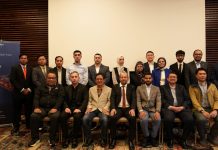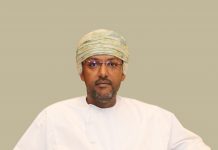SOHAR Port has completed 15 years of successful operations. What accounts for its continual success?
Successful projects all have one thing in common: They begin with a strong foundation. The foundation for SOHAR Port and Freezone was laid down by His Majesty Sultan Qaboos Bin Said when he envisioned a port and free zone in the North of Oman in the Al Batinah Region. This perfect location positions us just outside the Gulf but within proximity to global markets.
Oman and Suhar offer several benefits for companies that operate here, such as the availability of natural gas, electricity, skilled manpower, land and more. In fact, we can meet every industrial requirement right here at SOHAR. Moreover, our industrial area is connected to the sea and has superb transportation and logistics possibilities. We have also ensured ample room for downstream opportunities; Orpic refinery, for example, makes products that can be used by other industries.
Our presence in the city of Suhar has also positively influenced its growth and the growth of the entire region. This has, in turn, led to development in small and medium business throughout the region, especially with the demand for housing and amenities going up. We have been integral to the development of small business as the growth of SOHAR has created further demand for smaller industries right here in the governate.
We have always looked at SOHAR as a holistic business, one that is aligned with the goals of the nation, as well as our community. The reason for our success is that we continue to strike a balance so that we remain sustainable on the economic, environmental and people front.
Has SOHAR Port and Freezone positioned itself as a port of choice for East-West trade?
That is an interesting question. We believe that we have not only positioned ourselves as a port of choice; but we continue to prove our worth every day. We have attracted some of the largest local and international partners to our port and free zone including Vale, Oiltanking and Orpic amongst others. While we do a lot of business in Oman, the larger percentage of what we do serves international markets.
Overall, the split would be 100 per cent imports from international markets, 95 per cent exports and five per cent serving the local market. Overall, we are an international company that is largely invested in supporting the Omani economy, primarily as an employer, and in positioning Oman as a favorable investment destination.
How was SOHAR Port and Freezone’s performance in 2019?
2019 was a good year. Our growth is in line with that of the local and regional economies, and while growth has slowed, we are still experiencing success. We see a number of projects coming to completion. These include the Liwa Plastics Industries Complex, which will open in 2020; SV Pittie Sohar Textiles that has opened the second phase of their cotton yarn factory recently; and Indsil, which is setting up a ferrochrome smelter; as well as Strategic & Precious Metals Processing’s (SPMP) antimony-gold processing facility, which is being set up. These new projects will bring in extra volumes, and we expect 2020 to be another record-breaking year for SOHAR Port.
In 2019, we also completed the first phase of the SOHAR Port South expansion project that has added around 50ha to the port, and by competition of the second phase we look forward to a 200ha expansion. In addition to this, we have also enhanced efficiencies offering faster turnaround times and improved inspections. SOHAR has not done this in isolation, but in partnership with the terminals, customers and the Royal Oman Police. Our cooperation with government entities is constantly improving to further enhance the experience of our customers.
How much of tonnage has SOHAR Port done in 2019?
Tonnage though SOHAR port has definitely increased when compared to 2018; however, the final figures are yet to be tabulated. While the volume going through a port is certainly an interesting measure, it is by no means the measure of success of the port as the products that bring volume – chip aggregates for example – do not always bring in the largest profits, in terms of margins or employment. More important measures of success include the number of shipping rounds, growth of the industry as a whole and throughput numbers.
Please give us a brief on the latest developments and major milestones in SOHAR Port and Freezone’s operations?
We have a number of projects underway that will definitely add value to the port. We have identified space and especially space in close proximity to water as a major demand in our region, which is why we have two projects underway that will add around 19 per cent capacity to the port on completion. The first of these is SOHAR Port South – phase one is currently completed. The second of these is Terminal 2D, which boasts proximity to cool water and is the perfect space for minerals, metals and petrochemicals industries. We are currently leasing space at both of these locations; interest has been very positive and we have already entered a number of agreements in 2019. Of course, ours is an extremely long-term business; it can take one to two years to secure a partnership.
In addition to investing in our port’s capacity, we have also signed a number of interesting clients in the past year. We are welcoming new industries to SOHAR, including the first large-scale solar power plant in Oman. This is a key step in our mission to become a more sustainable port and free zone, and with this project we are gearing up towards our goal of providing around 1 GW solar power in the future. In addition to this, we continue to consider alternative energy sources such as hydrogen for various processes in our ports, which is far more environment friendly and it frees the available gas to be diverted for more remunerative use.
SOHAR has also entered into an agreement to build an LNG bunkering station at the port. Currently, LNG ships can bunker in Singapore or Rotterdam, hence this new station will open huge doors of opportunity for us in the GCC.
Like I said, ours is a long term business, so we have the benefit of foresight. We have a good idea of the agreements that we will enter into and projects that will begin/conclude in 2020; hence, we are able to make quite accurate business forecasts for the coming year.
How is SOHAR Port and Freezone’s vision aligning with the Sultanate of Oman’s National Logistics strategy?
We are a significant cog in Oman’s logistics strategy and play a huge role in the imports and exports of the Sultanate. Our next goal is to become a redistribution centre for the Gulf and surrounding regions. A large part of our business is driven by re-exports, and we feel there is a significant gap for us to play an even more significant role with the countries surrounding us. Once the road to Riyadh opens, for example, it will bring in additional benefits such as direct connectivity to a significant market like Saudi Arabia where cargo can be offloaded at SOHAR Port and the transported to Riyadh via road.
SOHAR Port and Freezone is developing three major clusters food, petrochemicals and metals. How is this progressing?
These are all extremely important industries for SOHAR, and all bring about ample upstream and downstream opportunities. The three planned clusters are moving ahead and are in various stages of development/operations.
We have aligned our food cluster and strategic direction with that of Oman’s food security strategy. Currently, there is a fully operational flourmill, as well as a world-class sugar refinery, a grain silo complex and an upcoming soya bean crushing facility. In the future, there is ample opportunity of the industrialized growth of food at SOHAR.
In terms of plastics, there is already a team working in close cooperation with Liwa plastics to scan the market and bring downstream industries to the free zone.
We have already witnessed successful upstream/downstream operations at SOHAR. MMEC Mannesmann and Acwa Power’s Sohar Calciner Plant, for example, will source petcoke from Orpic, calcify it to make anodes which will in turn be used in Sohar Aluminum. In Steel, we already have downstream industries such as ferrochrome, stainless steel, rebars and more.
What are the challenges facing SOHAR Port and Freezone?
Our main challenge is the economy and high interest rate. Despite these, we are growing and at a good rate. I am optimistic about 2019 and foresee us recording a higher growth in 2020.
What is your future outlook?
We are positive about 2020 and beyond. Currently our growth has slowed; in addition to the economic factors, we also didn’t have much capacity in terms of land, but with the development of SOHAR Port South, Terminal 2D and the second phase of SOHAR Freezone, we are once again in a good position to offer prime land to our partners and interest is positive. We are not only bringing exciting new industries to SOHAR, but also to Oman, which is incredibly exciting. We continue to put sustainability at the core of our operations to further enhance the port and free zone, reduce emissions and improve processes for our customers and the wider community.






